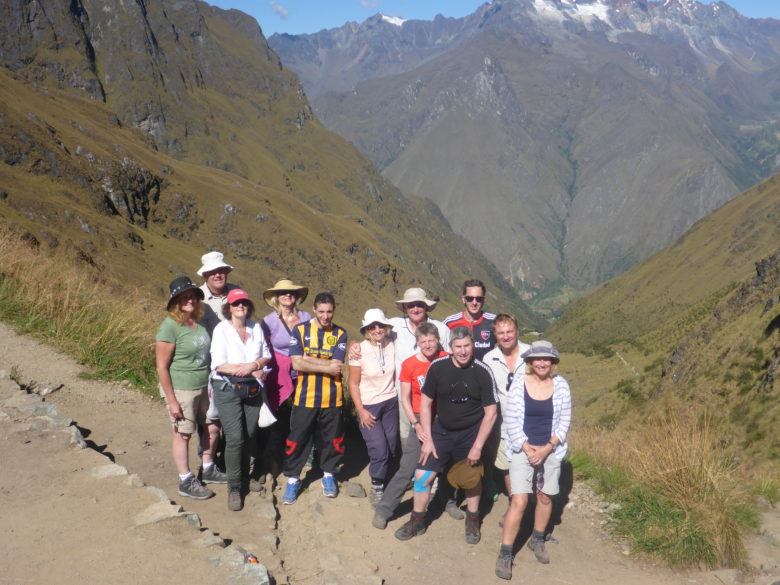Machu Picchu
13:26.60S 72:44.85W 1st camp @ 9000ft
27th April. We drove through Andean Peru as it awakened to another bright sunny day of toil. Shiny clean, uniformed school children rushed down to the main road from their farm homes to catch the school bus, as their grandmothers, tall hatted in their thick, knee length woollen skirts made their way to the fields for another stretch of scything and stood making.
We passed through passport control, stood in our new group of 12 trekkers for the mandatory photo and then set of for an 11 kilometre training day. We left behind us the raging, muddy Urubamba River and shared our path with donkeys and horses, one carrying an injured young lady back down from the heights.
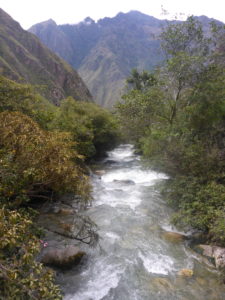
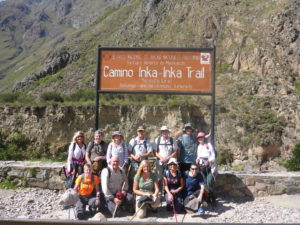
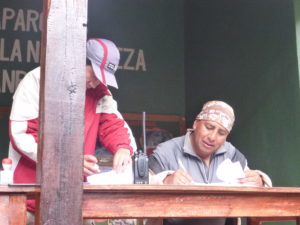
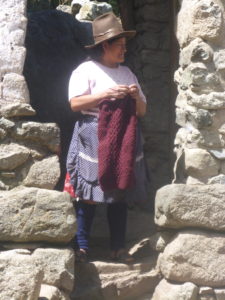
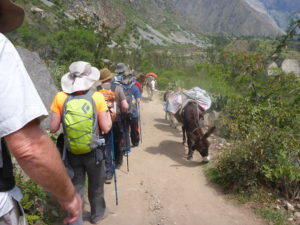
For our own safety we kept to the mountainside so the tough and loaded porters could run or walk past us without risk of us toppling over the edge.
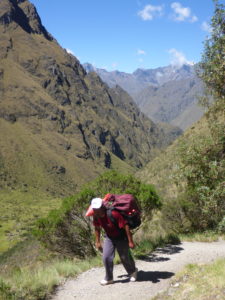
The porters used to carry up to 50kg loads but now they are limited to 25kg loads and lamas are much kinder on the surface of the mountain tracks than horses because they can only carry 20kg.
We reached a farmyard for lunch, where the porters had our dining tent already pitched. Soup and main course was the order of each meal. Some of our 23 porters will have gone to the nearest stream of clean glacial water and collected 5 gallon plastic containers full before boiling it on gas stoves to kill any bugs and then cooling it in the same stream ready for us to drink, wash our hands and replenish our water containers.
Ducks, geese, chickens, cats, dogs and a black pig wandered around, growing and fattening up, as we sat relaxing and chatting before setting off once more.
We had frequent breaks, including official breaks where there were flushing toilets with fabulous views from their terraces. The weather was perfect with clear blue skies and warm sunshine, visibility sharp to the mountain peaks.
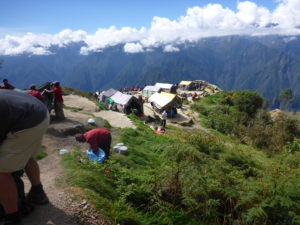
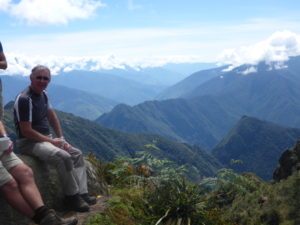
Frequently our guides Roger and Elvis would stop us to tell us about some interesting flora and fauna, beetles, spectacled bear’s, medicinal plants etc. An Aloe Vera lookalike could be used for fishing line and dental floss.
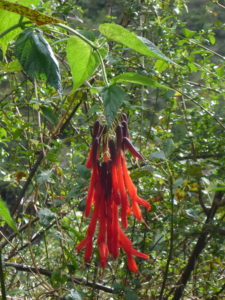
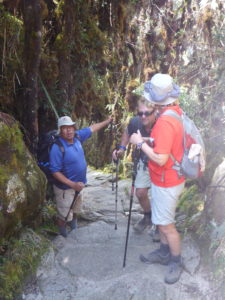
Our first camp in our orange Eureka tents was in the company of braying donkeys and crowing cockerels, near and far. In the fading light before supper we watched the young porters enjoying a game of football next to roosting chickens perched on the bannister of the farmhouse balcony.
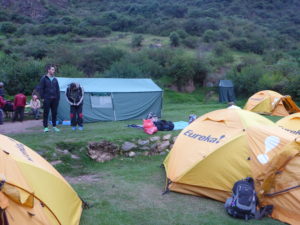
We jelled as a group very quickly, two Australian couples, a brother and sister amongst them, two Argentinian lads who have been friends since they were nine, a couple from near London, Karen was training for a sponsored walk in London for Breast Cancer, and Sonia and Anne from Falmouth who’d been friends for donkeys years.
During the night light from head torches, human glow worms, fireflies, shone through into our tents as campers peed around the edges of the field.
Our second day was due to be the most strenuous, Dead Woman’s Pass. Would this ‘dead’ woman make it I wondered as I relaxed in my cosy sleeping bag. I reckoned I would have to pace myself a bit better than on the first day. I had struggled to keep up with the vanguard movement at the front, and ended the day breathless and aching
07 May 2016 13:14.35S 72:29.2W Day Two
Warminannuska, Dead Woman’s Pass 4215mtrs.
We awoke to the sound of those cockerels and with a warming breakfast of quinoa porridge and Scottish pancakes inside us we set off knowing our porters would soon be overtaking us to set up the lunch camp.
Ahead was a steep uninterrupted climb of steps varying in height from below to above one foot for four and a half hours. I determined to pace myself so I would neither run out of breath, as I had on the first day, nor suffer from aching legs.
Rob stayed ahead with the leaders, his stride is longer and his pace faster than mine!
The reward at the top was immense. Snow-capped mountains, lush green slopes, the bluest of blue skies and pure white puffy clouds.
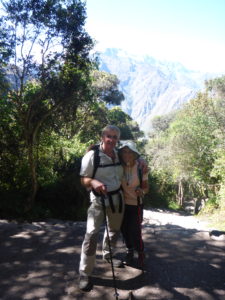
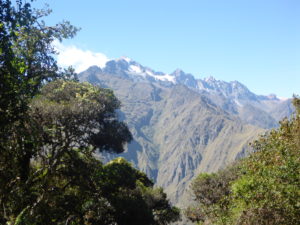
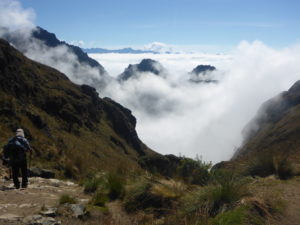
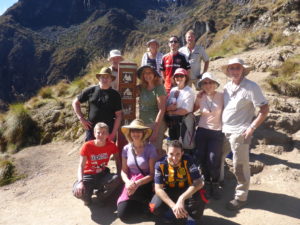
Surprisingly, the toughest part of the day was the steep descent to our second camp. Stepping sideways onto the next step down jarred the whole skeleton, especially the knee joints.
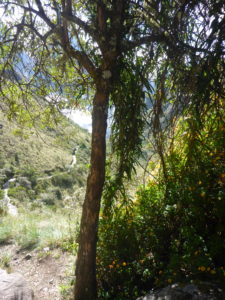
We had climbed well above the tree line in the morning and now we were descending back into the rain forest from the cloud forest above.
It was a big camp with each group occupying their own couple of terraces, one for the sleeping tents and another for the dining tent, in which the porters slept at night, and the ‘portaloo’ tent, approached with apprehension the first few times until we realised the bag was replaced frequently and it often beat the permanent loos, with their hit and more often missed holes in the ground, for cleanliness.
As darkness fell it became cool and very damp. All night frogs croaked close around the tents; a metre or two away from our plugged ears we could still hear them and the stream as it rushed to meet the Urubamba River hundreds of feet below. I noticed the water vapour in the beam of my torch while I checked for little frogs in the grass before I peed.
Our camp was 11,676 feet up in an Andean valley, no wonder it was cold and wet.
13:22.33S 72:49.87W. She’ll be coming round the mountain when she comes!
About 16000 years ago, at the end of the last ice age, people from China, Mongolia and Japan migrated east across the Pacific to the west coast of the Americas. Many stayed on the coast but others fled from the coastal earthquakes and tsunamis which we know are ongoing to the Andes and the jungle beyond.
The pre Incas developed over numerous civilizations, each taking the best from the age before. To transport goods and foodstuffs between the coastal region and the Andes and the Andes and the jungle further inland they used runners, each crossing his own terrain that he was familiar with to meet the next runner in say the Andean region. Tambos or resting places were set up like the hostels and inns that we have, and they are still there.
The Incas sometimes turned them into temples, watchtowers or forts, and now they are used by trekkers, farmers and town dwellers as tambos again for rest and relaxation, a perfect cycle.

At one point we looked down on some fine Inca ruins, perfect walls, neat terraces and still running waterways with crystal clear water.
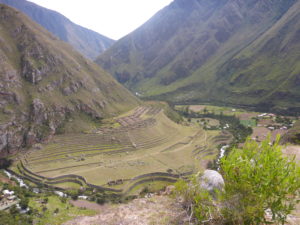
We were in the Sacred Valley of the Incas, never found by the Spanish in their ill-fated search for El Dorado because they were led up an alternative route by the clever natives.
The Incas, who thrived from 900AD to 1535AD, practiced genetic engineering on their plants to improve size and flavour so they could maximize the space on their agricultural terraces. They would then send the plants to farmers in the jungle to produce crops in the warm, wet climate. The exchange of skills and goods between the regions was extensive.
We were soaking up all these incredible facts from Roger as we looked down upon pristine, well cared for Inca habitations. Looking above us we watched a condor soaring and gliding in the thermals, the nearest we would get to seeing one.
More ups and downs and we came to a pretty lake, nestled between mountain ridges and anointed with a froth of low cloud. As we sucked hard sweets we could just see a family of white tailed deer, slowly grazing their way around the shore towards us.
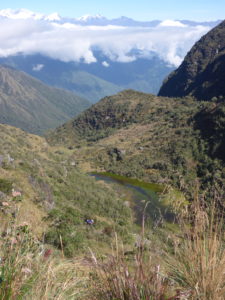
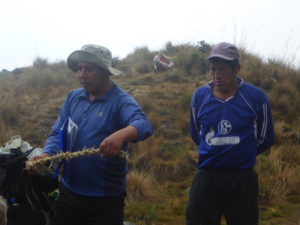
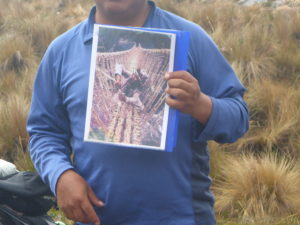
I was much relieved to have many breaks that day as my legs were reluctant to do what was needed of them. I just had to listen to them and not overdo the exercise. Consequently I was the tail end Charlie and would find concerned faces looking my way as I came slowly around the mountains with Elvis as my companion, to the waiting group. “What’s wrong Barb?” Australian Carmen asked, and I had to reply that I honestly didn’t know.
Our third camp was lower down, dryer, warmer and we had a musical accompaniment of cicadas to lull us to sleep.
13:16.96S 72:53.39W. Day four, to the Sun Gate
The trail was so much easier with long mountain hugging stretches of level track, in beautiful forest of long stemmed orchids and dripping spider web hammocks and a cool mist pervading the v-shaped valleys.
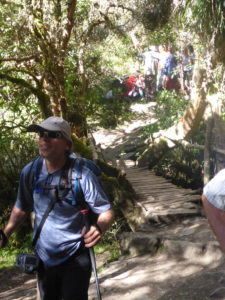
It had been an early start as the porters had to be at the railway station in Agua Caliente (Machu Picchu Village) for the 5.30am train with all our goods, as it was the only train they were allowed to catch according to Perurail.
So we were awoken with mugs of coca tea and basins of hot water at 4.00am. Rob and I didn’t fancy trying to get ready in 30mins so by the time our tea was delivered we had washed with baby wipes and were dressed and ready, just as well as they started pulling the pegs on our tent before we had exited!
Our packed breakfast was ready, cheese sandwiches, a bar of chocolate, piece of fruit and two sweets, along with a top up of boiled water, then off they ran, the porters taking 30 minutes for the rapid descent to the village, while we savoured our last 2 1/2hr hike.
We didn’t hold out much hope of seeing the sun rise through the gate overlooking the site as the clouds were clinging on to the mountains like a baby monkey to its mum.
Just before the Sun gate we had to climb 50 almost vertical stone steps. Roger and Elvis took our sticks so we had hands free to crawl, iguana like upwards. Half way up Carmen called “Hope you’re counting Barb.”
“28, 29, 30,” I made it 51 but never mind I wasn’t going back down to confirm. At the Sun Gate, our fog gate, pretty little birds cleared up our breakfast crumbs and the only sighting we nearly had was Australian Mike who threatened us with a moon, but fortunately was only teasing. This was after all a sacred place to many including our guides.
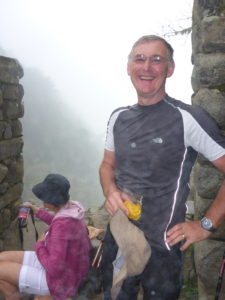
After our 7.25am breakfast we continued to MP and the trail was easy, my legs on top form, so Rob and I led the way.
13:09.23S 72:32.34W. The face of Machu Picchu
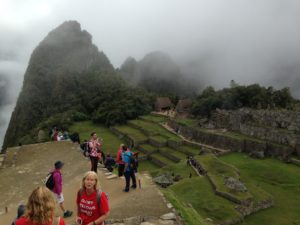
We had descended from 8,900 feet at the Sun Gate to the Sacred Plaza at 7400 feet. The gate is in the cloud forest (literally), the forehead of the forest and MP is at the eyebrow, the top of the rain forest. The weather was typical of the end of the wet season, November to March and Roger promised that the fog would gradually clear.
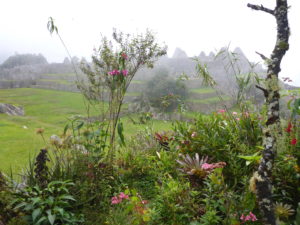
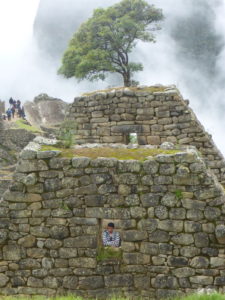
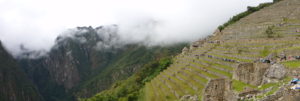
The site and the resident llamas are government owned, I remembered as three of these pretty creatures daintily tiptoed past me on the trail. Rob, Dave, Karen and I watched as one grazed it’s way along a grassy terrace and stood poised and thinking before nimbly leaping across the steps to the terrace opposite. The Incas had used these terraces for their genetic engineering experiments on crops, which is why today the Sacred Valley maize is bigger, paler and juicier than any other in the world.
The city dwellers, including the royal Inca and his family, pooed on the terraces as human waste was recognised as good fertiliser, while they peed in discrete little cells near their living rooms.
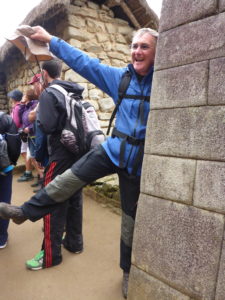
Sun Virgins lived in a group of fine houses across the plaza from the royal suites and their job was housekeeping, ensuring the royals were comfortable in every way. Above their residencies was the university where respected elders taught the younger generation about their culture, religion and history.
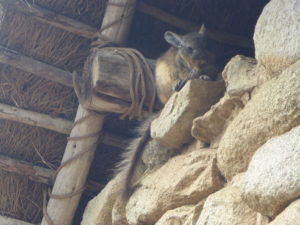
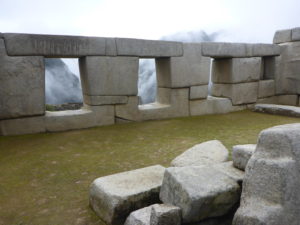
Numerous finely chiselled temples paid faithful respect to the Sun, Water, Mountains (their protectors and providers) and the Condor since it carried their souls to the Sun. The latter was partly natural with two sand and grey striped wings uplifted at the tips and a head and beak carved in pale stone and lying on the ground.
When the winter solstice foretold shorter days the Incas guaranteed the days would eventually grow long once more by sacrificing a llama, but at the summer solstice llamas were spared.
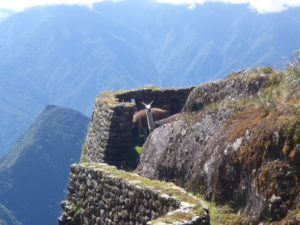
Roger’s tour was animated and passionate, we were so lucky to be drawn into his genuine interest and faith in his heritage. We stood by a carefully managed sacred garden full with fragrant medicinal and exotic plants and we’re faced with a choice. We could climb up to the classic viewing spot and have our photo taken with that backdrop you all know, waiting in a long line of folk on a narrow path or we could have another ‘ramble round the ruins’, or we could go for a beer.
The peaceful atmosphere of this beautifully manicured site was beginning to lose its majestic and sacred appeal with the influx of coach loads of visitors armed with cameras and umbrellas and speaking in loud accents so we migrated to the bus stops for a rapid 25 minute ride down the zig zag road to the village with Roger, who led us to the Apu Salkantay restaurant and we sat around a vast table with comfy settee seats he had booked for our final lunch.
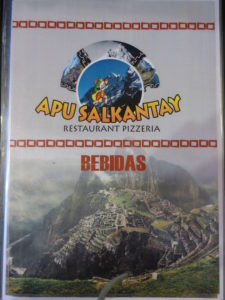
The railway took up most of the narrow street, every now and then women would hastily retrieve their wares from between the rails to let a train trudge slowly past before re-instating their stall on the track. The restaurant had no windows, so it was possible to almost touch the roof of the train from our room on the first floor.
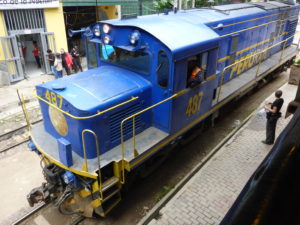
We slowly supped our beer and chatted to Dave, Karen and Roger and learned through the restaurant Internet on Rob’s phone that Zoonie and the other yachts were unscathed for the time being at least. But then Rob’s phone also told us the area was experiencing aftershocks of around 3.1 magnitude every day.
We said our fond farewells to our group before boarding our lovely observation carriage on the train for a beautiful ride back alongside the rushing Urubamba, surrounded by mountains in all their sun lit and snow-capped glory and fields being harvested and ploughed with oxen and manpower.
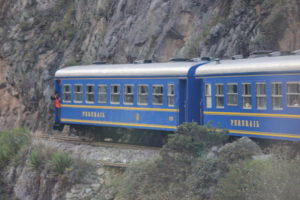
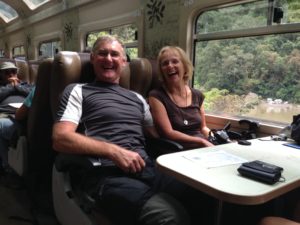
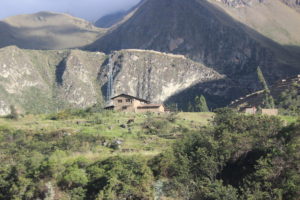
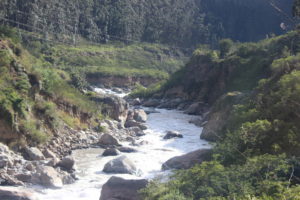
Back in the same room in our hotel in Cuzco we had used before the trek we found the beds had been turned back ready for us, hmm so homely. We took the lift up and down to help our limbs to recover. The ache in my right hip has finally gone and the trek actually cured the odd backache I had before the start.
Our last day in Cuzco was spent shopping for a new case for me as I’d managed to pull the zip off my old one before leaving it at the hotel for the trek. Rob”s soles had separated from the uppers so he bought new shoes and put the old ones in the bin. The person cleaning the room must have thought we’d binned them in error as they were back in the wardrobe when we returned.
The next day we were back at our hotel in Lima enjoying our complimentary pisco sour cocktail and planning our last day there. It would be Rob’s birthday and we would take off at 5.30pm for Bogota on our journey home but not before a birthday lunch at the Punta Azul restaurant just down our street. On the way in I just let slip Rob’s birthday status to the waiter and they did the rest as you may have seen on Facebook.
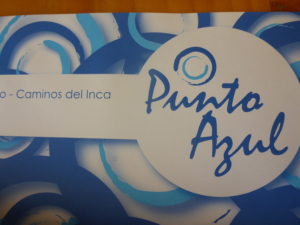
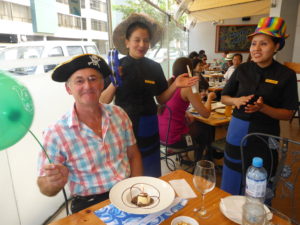
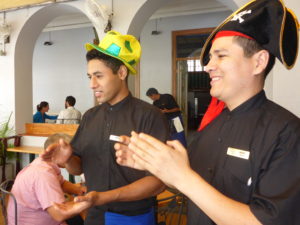
We were picked up for our transfer to the airport and our escorts promptly fell asleep in the front passenger seat. When I looked at the bus next to us everyone of the passengers was fast asleep, instead of on their mobile phones, well it was a warm, sunny afternoon in Lima!
